Here we go again. Another of my way-overdue review round-ups of new books related to animation – past, present, and future! Not all of these will be of interest to you, though several are (in my opinion) “must-haves”. Here they are presented in no particular order… though I must begin with Giannalberto Bendazzi’s three-part omnibus…
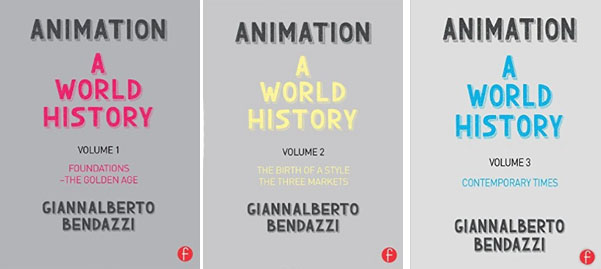
Animation: A World History by Giannalberto Bendazzi (CRC Press/Focal Books).
Bendazzi’s previous Cartoons: One Hundred Years Of Cinema Animation (1994) is still a major reference book and much-referred to by me as a concise source of accurate information on the key players and films in animation history. The author has spent over a decade updating, revising, improving and adding much of it and the end result, Animation: A World History, turns out to be just as vital.
And update it he has! Bendazzi breaks down animation history into three volumes, covering six “periods”: #1 The years before Cohl’s Fantasmagorie (from approximately 3000 BC to 1908); #2 The silent era to November 1928; #3 The Golden Age, 1928-1951 – These are in the first volume; #4, from 1951 to 1960 (the date of the first Annecy International Animation Festival); #5 1960-1991 covering the Cold War era and the growth of television animation – both in Volume 2; and #6 covering 1991 to 2015, present day animation and animators, in Volume 3.
Is this the ultimate animation history book(s)? No, there may never be such a thing – but this is darn close. It is perhaps the most thorough examination of the entire field in three volumes. At the very least it’s a starting point for all further research, and a handy resource for the basic facts of the medium’s history. At best, it’s an incredible read – Bendazzi weaves the whole story together in a very enjoyable, easy to reference way. There is no question I’m keeping these volumes close as I continue my own work. These books should be on your shelf if you teach animation history, love animation history or are intent on making animation history.
Birth of An Industry: Blackface Minstrelsy and The Rise of American Animation by Nicholas Sammond (Duke University Press)
 Boy – what a subject for a book! University of Toronto Associate Professor Nicholas Sammond examines the connection between blackface minstrel shows of the late 1800s and early 20th Century and how that form of popular entertainment influenced the earliest animators and their cartoon stars.
Boy – what a subject for a book! University of Toronto Associate Professor Nicholas Sammond examines the connection between blackface minstrel shows of the late 1800s and early 20th Century and how that form of popular entertainment influenced the earliest animators and their cartoon stars.
Ever wonder why Mickey Mouse, Flip The Frog and Bugs Bunny wore white gloves? Or why black characters of the 30s such Bosko or Bimbo appear designed in white face? Or why there were so many black musical cartoons? Sammond addresses these questions by examining the roots of black (and white) vaudeville entertainment and how the animated cartoon took over these attributes after film killed off live shows.
He also looks into the rise of animation production, how that came to be and how it settled into a factory system in line with industrialization of the day.
Birth of An Industry tackles a politically incorrect subject head-on and examines it thoroughly. The topic may be controversial, and the cartoons hard-to-view, but the subject is still fascinating.
Inks, Drinks and Catfinks by Shawn Dickinson (Yoe Brow/IDW Publishing)
 I love Shawn Dickinson’s artwork so much I was asked to give a quote for the intro and I jumped at the chance. Here’s what I wrote:
I love Shawn Dickinson’s artwork so much I was asked to give a quote for the intro and I jumped at the chance. Here’s what I wrote:
“Inspired by past masters like Max Fleischer, Ed “Big Daddy” Roth, Ub Iwerks, and Bob Clampett – Shawn Dickinson’s work embodies the traditions of classic cartooning by stretching, squashing and pushing the boundaries of good taste, just for the fun of it. I can’t take my eyes off his work – the detail, the layouts, the ink lines – wall-to-wall appeal. Each image distills the essence of the classic Hollywood cartoon – and if you are like me you’ll be staring at these beauties for longer than seven minutes. Consider me a huge fan.”
Now all of his commercial art, paintings and personal stuff has been collected into a big coffee table book, Inks, Drinks and Catfinks, published by the infamous Craig Yoe and IDW – and it’s a glorious thing of beauty. I haven’t much more to add – except to post two (of the hundreds) in this book. This will give an idea of why I love his work:

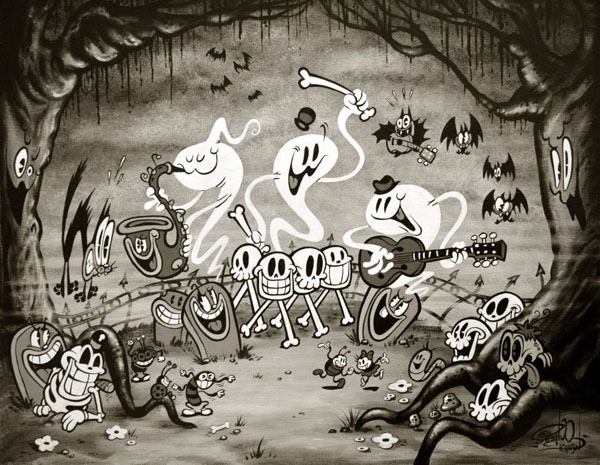
Need I say more?
Comedy For Animators by Jonathan Lyons (CRC Press/Focal Press)
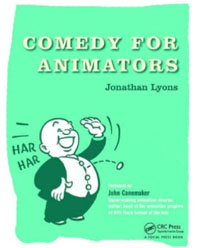 This book took me by surprise. A delightful surprise. It doesn’t preach to animators, nor explain how to make a funny cartoon. It is essentially a history of comedy – it’s archetypes, the cliches, and all the basic, essential information – a deep dive into the roots of why we laugh and what makes us do it.
This book took me by surprise. A delightful surprise. It doesn’t preach to animators, nor explain how to make a funny cartoon. It is essentially a history of comedy – it’s archetypes, the cliches, and all the basic, essential information – a deep dive into the roots of why we laugh and what makes us do it.
And its not a stuffy academic read. Author Lyons (a former student of John Canemaker, who contributes a Foreword) traces things from the times of the ancient Greeks through Commedia Dell’Arte, Shakesphere, vaudeville and silent film. Chaplin, Keaton and the Three Stooges are among the live clowns highlighted; definitions of parody and satire are illustrated; examples of classic film comedy is cited and discussed.
It’s no laughing matter – Comedy For Animators should be inspirational reading for anyone attempting to make humorous animation. Check it out.
How To Be A Disney Historian by Jim Korkis (Theme Park Press)
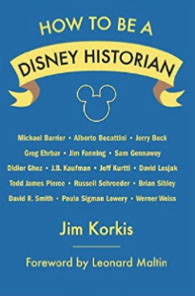 Our own Jim Korkis has compiled a fascinating little book for those of you who dream to be a full (or part) time animation historian. He sets into print some practical information about what to do, what to expect and tells how he himself got started in this line of “work”.
Our own Jim Korkis has compiled a fascinating little book for those of you who dream to be a full (or part) time animation historian. He sets into print some practical information about what to do, what to expect and tells how he himself got started in this line of “work”.
Jim goes over the basics of doing Disney research in the first half of the book – this includes useful information from David R. Smith, and a Foreword by Leonard Maltin. In the second half, Jim includes some “Good Advice” essays from fifteen esteemed colleagues – which include such notorious figures as Michael Barrier, Alberto Becattini, Jim Fanning, Didier Ghez, David Lesjack, Brian Sibley and our own Greg Ehrbar and J.B. Kaufman. In the interests of full disclosure, I also contributed a piece to this tome.
I’m not sure who the audience for this book is (I don’t think Jim really knows either) but it is an earnest attempt to “pay it forward”. I only wish I had such advice when I was just starting out. There are some good tips and new tricks to be found in the pages of How To Be A Disney Historian – readers of this site should find it all particularly interesting.
Molly and The Bear by Bob Scott (Cameron + Company)
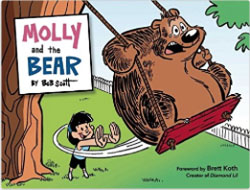 And finally – Good news, everyone! Molly and the Bear has now been collected onto print media (where its belonged all along) in a huge new coffee table book from Cameron + Company.
And finally – Good news, everyone! Molly and the Bear has now been collected onto print media (where its belonged all along) in a huge new coffee table book from Cameron + Company.
I’ve always admired Bob Scott’s web comic, it’s so damn good looking. It feels like an animated cartoon in four panels – and for good reason: Scott is a trained animator who has credits on Cats Don’t Dance and The Incredibles (among much else).
The strip (which started in 1997) concerns 11-year old Molly, her nine-hundred pound talking pet bear, along with her somewhat patient Mom and Dad. The new book collects literally hundreds of strips, along with some fantastic back pages bonus material (sketches, pencils, roughs, promotional images and some wonderful retro “Sunday section” comic pages). Good stuff, sez I. Lots of fun. Highly Recommended!
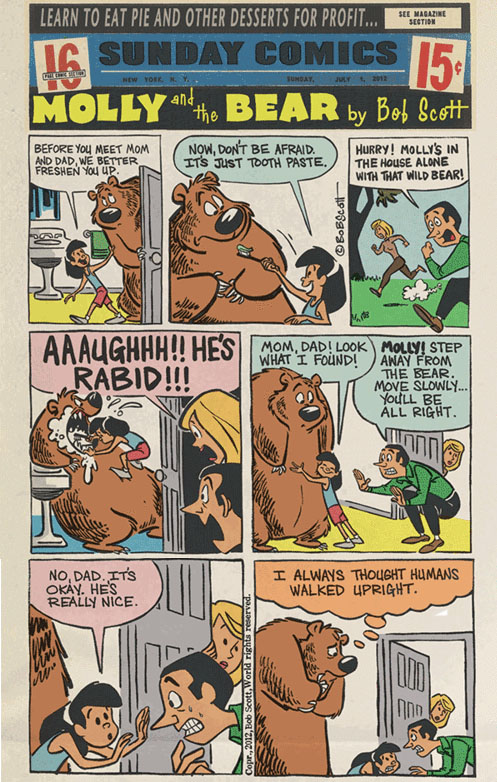


 Jerry Beck is a writer, animation producer, college professor and author of more than 15 books on animation history. He is a former studio exec with Nickelodeon Movies and Disney, and has written for The Hollywood Reporter and Variety. He has curated cartoons for DVD and Blu-ray compilations and has lent his expertise to dozens of bonus documentaries and audio commentaries on such. Beck is currently on the faculty of CalArts in Valencia, UCLA in Westwood and Woodbury University in Burbank – teaching animation history. More about Jerry Beck [
Jerry Beck is a writer, animation producer, college professor and author of more than 15 books on animation history. He is a former studio exec with Nickelodeon Movies and Disney, and has written for The Hollywood Reporter and Variety. He has curated cartoons for DVD and Blu-ray compilations and has lent his expertise to dozens of bonus documentaries and audio commentaries on such. Beck is currently on the faculty of CalArts in Valencia, UCLA in Westwood and Woodbury University in Burbank – teaching animation history. More about Jerry Beck [



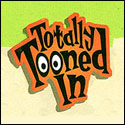



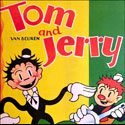
Oh man, every time I read your book reviews, Jerry, I feel bad that I’ll get to read none of these!! I’d love to immediately read Nicholas Sammond’s book, connecting classic theatrical animation to vaudeville and the minstrel shows and, yes, there is a great deal to discuss there. I have my own theory, but I like to discuss the stuff. Have you ever met the author of this book? This is why you should continue your radio gig and have him on as a guest, with audio sections of certain cartoons like “THE OLD MILL POND” which is, without its visual, an all-singin’, all-dancin’ musical.
Remembering some of the visuals, I’d go so far as to say that it is practically filmed as if it were a live stage performance. There are so many questions I’d have for this gentleman on how he became fascinated with the subject, and I guess I should say “fascinated” with quotes, but it is an interesting topic. In fact, I’d say that early animation of the theatrical golden age was heavily influenced by black and white vaudeville…oh, and feeling as I do about comic panels, I’d scoop up the books compiling recent comics panels by those examples you gave here. Animation, in general, is such a rich topic, and that is why I’m always yowling for more, more, more full and complete volumes of classic cartoons…*ALL* cartoons!